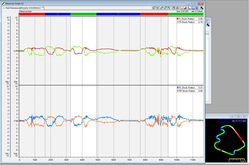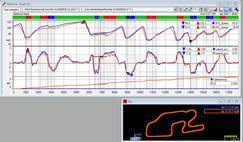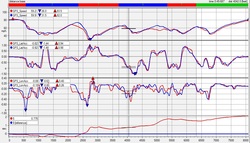
Check out this trace and see what you notice. The top graph is the front shock positions and the bottom is the rear shock positions.
 Ever notice one car doesn’t look as good over the bumps as another. Most times we chalk it up to better dampers, different suspension designs, or even the driver’s skill and/or track position when they hit the bumps. While those things certainly play a major role in how the car looks and handles, sometimes there is more at play. Check out this trace and see what you notice. The top graph is the front shock positions and the bottom is the rear shock positions.
0 Comments
 Shock data can be used for many different things. Lots of times, it’s thought that the shock data is only good for tuning – finding that sweet spot of dampening. Just as often, the shock data can show other things, especially when something is wrong in the suspension. While the data won’t tell us exactly what is wrong, it can show us symptoms of the root cause and allow us to dig deeper.  At some point, when you decide to get a data system, you’re faced with what data to gather. If you have a car where you can tap into the CAN Bus, you’ll probably have all of the info you want with a simple two wire hookup. For those with an older car, you’ll have to start planning on what data you want and how to collect it. Regardless of the brand dash / data logger you’re using, they all accept a multitude of sensors.  Everyone knows the old adage “A picture is worth a thousand words.” In data, we use all kinds of pictures – regular graphs, XY plots, histograms, and many more. Those graphs, while technically pictures, sometimes lend themselves to those with a “math mind.” When we add video to the data, it really adds 1,000 words.  Does it make sense to put a $400 AiM SOLO in a $500 Lemons race car? Of course it does! Within our small team of 5 folks, we were each able to improve our individual lap times by comparing our speed, longitudinal G, and lateral G force graphs. Throw in the ability to use the GPS features to compare our driving line and we had one teammate lose over 3 seconds on a one minute 31 second lap. That is a serious improvement!  This contribution comes from Dave Scott, Lead Instructor at RaceCoach.Net. Dave has experience working with many drivers across all levels of driving and has helped a lot of people learn to drive faster. Check out what is important to him in teaching folks to go faster. I coach a lot of drivers. A majority are racers (from rookies to very experienced) or folks actively preparing themselves to race. The rest are experienced track day instructors and drivers looking to improve their skills. |
Featured ArticlesHere is a collection of articles from some of the best professional coaches, drivers, and data engineers. Archives
May 2017
Categories
All
|
